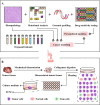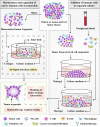Tumor organoids: applications in cancer modeling and potentials in precision medicine
- PMID: 35551634
- PMCID: PMC9103066
- DOI: 10.1186/s13045-022-01278-4
Tumor organoids: applications in cancer modeling and potentials in precision medicine
Abstract
Cancer is a top-ranked life-threatening disease with intratumor heterogeneity. Tumor heterogeneity is associated with metastasis, relapse, and therapy resistance. These factors contribute to treatment failure and an unfavorable prognosis. Personalized tumor models faithfully capturing the tumor heterogeneity of individual patients are urgently needed for precision medicine. Advances in stem cell culture have given rise to powerful organoid technology for the generation of in vitro three-dimensional tissues that have been shown to more accurately recapitulate the structures, specific functions, molecular characteristics, genomic alterations, expression profiles, and tumor microenvironment of primary tumors. Tumoroids in vitro serve as an important component of the pipeline for the discovery of potential therapeutic targets and the identification of novel compounds. In this review, we will summarize recent advances in tumoroid cultures as an excellent tool for accurate cancer modeling. Additionally, vascularization and immune microenvironment modeling based on organoid technology will also be described. Furthermore, we will summarize the great potential of tumor organoids in predicting the therapeutic response, investigating resistance-related mechanisms, optimizing treatment strategies, and exploring potential therapies. In addition, the bottlenecks and challenges of current tumoroids will also be discussed in this review.
Keywords: Cancer; Drug discovery; Organoid; Patient-derived xenografts; Therapy response prediction; Tumor microenvironment.
© 2022. The Author(s).
Conflict of interest statement
The authors declare that they have no competing interests.
Figures



References
Publication types
MeSH terms
Grants and funding
LinkOut - more resources
Full Text Sources
Other Literature Sources
Medical

